Archive for October, 2009
Other Bases of Antarctica and the Treaty
Answering some more questions I have received!
There are many other bases in Antarctica however, we don’t get together and have tea and biscuits! The other stations are quite a distance away.
Antarctica has been set aside as a scientific preserve for scientific investigation there is to be no military activity on the continent. Antarctica has no “permanent population” and hence no citizenship or government. However, theTreaty which was signed by 47 countries has 21 Articles which regulates activities by the signators on the continent.
Crane Driving
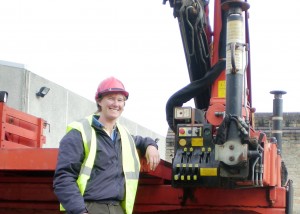 For the last two days I was up in Cambridge at BAS learning to drive the cranes they have mounted on the snow cats. The one I was learning on is actually the smallest one they have. It is a bit like I imagine driving a tank is like – slow and hard to maneouvre. Instead of a steering wheel there are two levers. It was such fun playing around with the machine learning to sling things and move them about the yard. The reason I am being taught this is so that I can load the boats in the water as the slipway was taken out by a storm at Rothera. At Halley which has no boating they take about 2 months to unload the cargo ship and use these machines everyday. Oh and I get a license that looks like your drivers license to allow me to drive them anywhere I want!
For the last two days I was up in Cambridge at BAS learning to drive the cranes they have mounted on the snow cats. The one I was learning on is actually the smallest one they have. It is a bit like I imagine driving a tank is like – slow and hard to maneouvre. Instead of a steering wheel there are two levers. It was such fun playing around with the machine learning to sling things and move them about the yard. The reason I am being taught this is so that I can load the boats in the water as the slipway was taken out by a storm at Rothera. At Halley which has no boating they take about 2 months to unload the cargo ship and use these machines everyday. Oh and I get a license that looks like your drivers license to allow me to drive them anywhere I want!
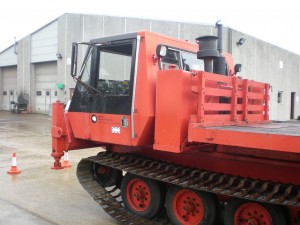
Old Days
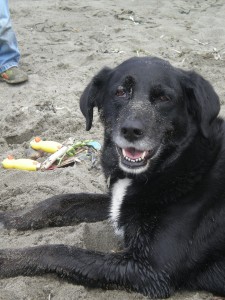 One of the things I am missing and will continue to miss is ‘my’ dog Draeger who is a beautiful Lab Collie mix. I really wish we were able to have dog teams down on base unfortunately they were removed from base in 1994 see the below movie about them.
One of the things I am missing and will continue to miss is ‘my’ dog Draeger who is a beautiful Lab Collie mix. I really wish we were able to have dog teams down on base unfortunately they were removed from base in 1994 see the below movie about them.
Rolex Middle Sea Race 2009
Last week Myles and I went to Malta to race on Hooligan VI a Farr 40 in the Rolex Middle Sea Race. Although we did not win the race or actually do that well we did finish which is better than 30 or so other boats and we had an interesting race.
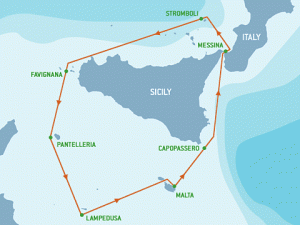
The course is 605 miles or so long but with the beating legs that of course makes the course longer. It takes you from Malta up to Sicily and around the north side and then around several islands including the active volcano of Stromboli returning to Malta. Interestingly you get very close to the Libyan waters and can see the glow of Libya in the night. You also go past Mt Etna on Sicily – who knew that it was snow capped!
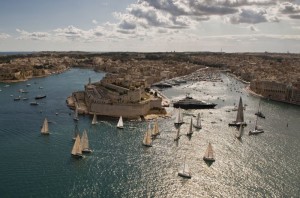
Photo credit: Rolex / Kurt Arrigo
The start and finish is in the Harbor with the start in Grand Harbor under the shadow of Fort Elmo and the Venice like city of Valletta (the city planned and built 450 years ago by the Knights of the Order of St John). The starting gun was not diminutive in fact it was a massive signal cannon which is traditionally fired at midday. There was a crowd lining the curtain walls of Valletta and Vittisoria (one of the three cities) the most people I have ever seen interested in a yacht race with the small boats starting first in a light breeze.
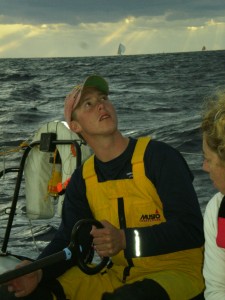
The weather during the race was varied we saw 2-42 knots and there were races within the race which if you were able to shift gears quickly meant you did well. At night the combination of the cold northerlies and the very warm sea water created an environment for squalls, water spouts and large thunderheads. These were incredibly hard to see or anticipate as there was no moon. The squalls hit fast and hard so it was necessary to become very fast and at throwing reefs in and out and taking down spinnakers as the wind direction would shift dramatically. These micro systems brought hail (I am not kidding) and rain that stung on impact making it hard to see. The nights were extremely long with 13 hours of darkness putting an emphasis on organization for the night period like the necessity to tag reef lines in and out – reef one to reef three etc.
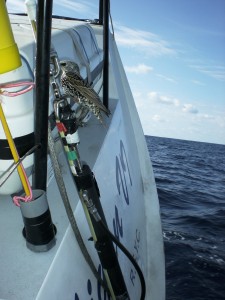
At one point the number one reef line came out of the boom entirely luckily when the sun came up there was 10 knots of wind so we were able to tag out the second reef and use it to tag in both reefs. It did necessity the removal of the sheaves in the aft of the boom which with a cat’s cradle of line we were able to do without dropping the main but required quite a lot of balancing. Once that was repaired we started to become competitive about how quickly we could throw reefs in and out with 3 or 4 people on deck. The best time was around 1 minute which meant on our last ¼ mile to the finish inside the harbor meant we only lost ½ a boat length when it came to shaking out the reef! The hardest process is the fact that the main halyard is clutched down below on the Farr 40 so you have to rig up a block to get it up on deck to a primary winch. We ended up at night leaving it off the clutch and on a winch on deck so we could react quicker however, this left lines that people tripped over.
We had a few other gear issues including the chafing through of the cover on the jib halyard requiring Myles to go up and resolve the problem and I repaired the halyard. The main winches on a Farr 40 are under sized which puts a load onto the brass pawl housing creating ovalling and end result is the winches were back winching (not terribly safe). As a result we had to tie off one end of the sheet and cross sheet on starboard tack to the primary with the mainsheet. It is so important on a Farr 40 to be able to trim the main continuously. The speedo stopped working about 100 miles from the finish meaning the instruments basically were useless. After the speedo was removed checked and returned to the housing we had some excitement when we had an internal 4 foot waterspout after the speedo blew out – obviously it had not been put back correctly. Lots of bailing later the boat was no longer sinking!
The crew was all very nice people with 3 students taking a lot of the weight of sail changes and general running around trying to make the boat fast. Our navigator an ex merchant seaman is very English and was constantly brewing tea sometimes twice per watch – I did find it a little hard to deal with when we had four on deck and all their hands were needed but instead mugs were being clutched. I can see this is a great morale raiser in the cold English Channel conditions. I did have a chuckle when at three am upon waking for watch I was quizzed about where the teaspoon might have disappeared to as it is ‘jolly hard to make tea with a dessert spoon”! We used the boil in the bag camping food and it was not bad at all with the Hot Pot winning the trophy for the best tasting. I don’t think you want to see what it looks like though it is much better to just eat it in the darkness ?
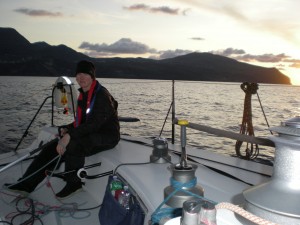
The ‘kids’ efforts combined with a 3 hour on and off watch system meant I got quite a lot of rest in comparison to the Caribbean 600! So although we did have gale force conditions they didn’t last long and life was not that uncomfortable. The boat was a lot drier than the IRC 46 however, I would have preferred to have my Kokotat drysuit as I am in love with it and don’t like getting wet.
The last 30 miles we match raced two other boats with the local Maltese knowledge helping them to gain on us dramatically on the way up the Maltese coast. The kids really got into trimming the boat constantly and with everyone on the rail the boat was sailed at a lot higher percent of its potential. Three boats finished within a minute of each other with us the middle boat doing an interesting method of tacking with two winches that didn’t work.
So all in all a fun race with amazing scenery and good company.
Contact with the world!

Lots of people have been asking me about my contact with the outside world when I am on base. So here goes…
Internet – The entire base has a bandwidth of a 1/5 of your broadband you have available to you when you are sitting at home or work reading this post. That bandwidth is for all communication for 120 people with the outside world. A large percent of that is needed to keep the base running and for scientific data transfer. So that leaves a very very small amount for everyone’s personal interactions. So I can’t access websites – no surfing the web, no Skype or posting on facebook etc. I have set up a system where by I can email my blog updates and they will appear on my website so this is the best place to get my news.
Email – I can send and recieve email through my BAS email (my personal email will be forwarded after the spam is removed to my BAS account) maximum file size of 1MB an email. The subject line of the message should only show the words “Personal” i.e. Subject: Personal. When an e-mail is sent to myself, an automatic receipt will be generated by the BAS messaging system advising that your message is queued for transmission and this receipt should be received by you the next time you check your mail. Whilst the various satellite connections provide the potential for a 24/7 service, it should be noted that weather conditions can and do affect its operation. This may mean that the service is interrupted or unavailable at times.
Why the small bandwidth! – well rightly so BAS doesn’t feel it is a good use of the British tax payers resources to provide us on base with enough satellite time for us to surf the internet and the money should go towards the science research. The American bases have full bandwidth and we could as well but it would cost another 1 million pounds a year. On that point BAS spends 45m pounds per year to support all the staff, two ships, airplanes and bases and is the most prolific country in terms of writing science papers from data collected in Antarctica. The US spends the whole BAS budget per year just to maintain the roads at one of their stations – McMurdo!
Letters/Parcels – I can send and receives letters and parcels if you want more information about that go to BAS site. I am based at Rothera and will be there from November through March.
Phone – You can’t phone me! Basically that is what it comes down to. I can however, phone out from base using satellite phone.
Life – BBC1 about Antarctica wildlife
Tonight there was a program on BBC1 called Life. If you click here you will get to the online version of it. The beginning is really amazing about bottlenose dolphin hunting techniques. To get to the stuff about Antarctica without watching the whole hour long program there are three sections you can fast forward to
10:30 on the clock it has about 5 minutes
40:30 to 46:00
48:00 to end
Enjoy… Oh one more amazing fact. Leopard seals can open their mouths 180 degrees and have teeth bigger than lions…
Relaxing Sunday with some golf!
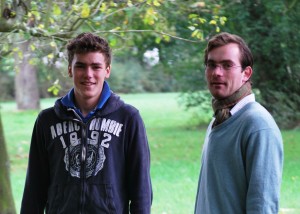
Sunday was a relaxing day thankfully after a 2:30am bedtime. Gus took me to his Grandpa’s farm which has been in the family for over 150 years. Large tracks of land around the farm are leased to farmers and there are five beautiful old brick houses around a courtyard. We visited a while with his grandfather and youngest brother it is good to see Gus so comfortable in his favorite surroundings.
Yet another tasty meal cooked by Gus’s mother of salad, meat and potatoes with fruit and ice cream. Northern French families typically have 4 to 6 children and Madam Motte somehow manages to look beautifully young having brought up five boys. Now all but one have left the nest she is doing her MBA!
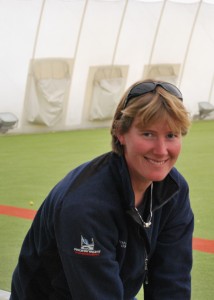
An afternoon with a first for me – attempting to play golf at the driving range. My first attempts were feeble I totally missed the ball a multitude of times. Then I would connect with the ball and it would either end up flying high and left or rolling feebly several feet away. The way you are meant to hold the club was not that comfortable and I ended up looking like a baseball player according to Gus.
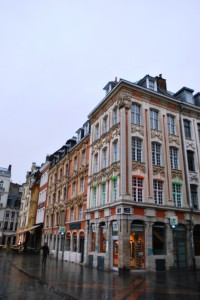
With a few hours to spare I had a tour of Lille city center in the rain, the high school, Gus’s old house before getting onto the Eurostar for my quick trip back to London.
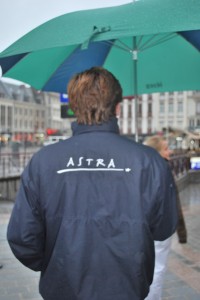
Hunting and Eating in Lille
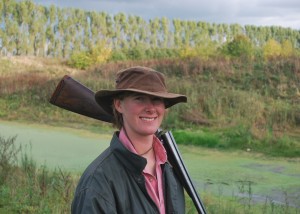
On Friday I took the Eurostar to Lille from London it is a very painless if a little expensive way to get to France. From my door to my friends door in Belgium is 3.5 hours sitting either on a train or in a car.
In a typical French manner although I arrived at 10pm it was time to go to some friends house for dinner! Dinner was a simple and delicious a typical mountain meal. You are given slices of cheese which go in a special tray under heat and it melts. You then eat the melted cheese along with roast potatoes and sliced deli meat.
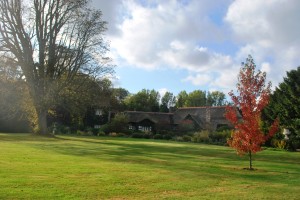
Saturday morning up early to get to our hunting hosts (Katherine and Stephan) house in time to help prepare for 25 people arriving for brunch. A simple delicious affair of cheese, bread, jam, ham, fruit, tea, coffee and hot chocolate on a beautifully decorated table with arrangements of hydraingas from the large garden. The house is in the middle of may acres of farmland which was sold separately from the house but the hunting rights remained with the house. The hunt happens twice a year so I was lucky with the weekend I had available to visit my friend Gus.
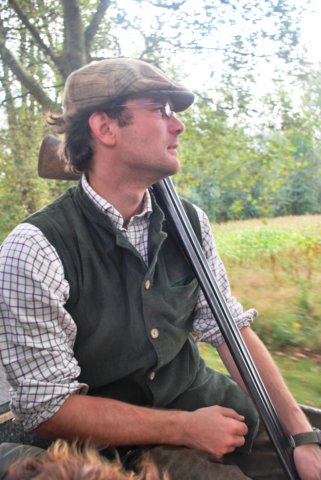

About 30 people join in including wives, girlfriend and children all acting as beaters. It takes quite a lot of organization with two vehicles, negotiations with the farmers whose land is being used and feeding the mass of people. There are the hunting dogs as well running around very excited at the prospect of finding some game. Everyone seems to be either family or friends who have known each other for many years – all welcoming to the English/American who speaks a very small amount of French badly! We hunted for 4.5 hours bagging about 52 animals – partridges, pheasant, hare and duck. Dinner was a four course feast lasting a few hours – coq au vin with potatoes and mushrooms, cheese, salad and the most amazing chocolate cake I have ever tasted (each bite a taste of heaven).
Check out the pictures from the hunt here.
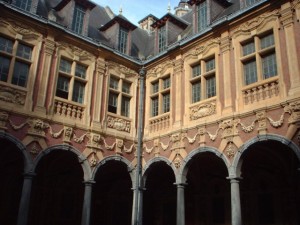
Again another late night leaving for the center of Lille a picturesque cobblestoned city at 10:15 – I admit normally my bed time! The historic buildings were beautifully lit including the old stock exchange, theatre and a multitude of other building that thankfully survived the wars.
Oh btw despite the photo I wasn’t allowed to shoot so acted as beater and camerawomen as I don’t have a French hunting license and probably wouldn’t have got anything if I had attempted to shoot 🙂
No Polar Bears…
To answer a few more questions..
So despite the cartoons and cards making you think otherwise penguins and polar bears are not found on the same continents!
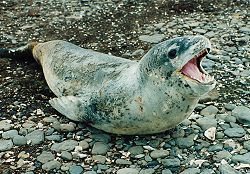
The equivalent of the polar bear in Antarctica is the leopard seal they are the top of the food chain. They have virtually no fear, except for those of orcas, or killer whales. The equivalent in the Arctic of penguins is the puffin.
The word Antarctica comes from the Greek. It means “south of the bear”. They are referring to the word Arcos, which is a constellation that can only be seen in the northern hemisphere.
More than 2000 years ago, Greek writers described a large mass of land in the south of the world. Even though they had never seen it, they believed it must exist so that it could ‘balance’ the land they knew about in the northern half of the world. They named this imagined land ‘Anti-Arkitos’, meaning the ‘opposite of the Arctic’.
There are no native people of Antarctica the only inhabitants are those living on research stations around 5000 in the summer and 1000 in the winter. The Rothera base summer compliment is 120 and winter 21. The closest base to us is the Argentines at San Martin base about 40 miles to the south however, there isn’t any popping over for dinner.

